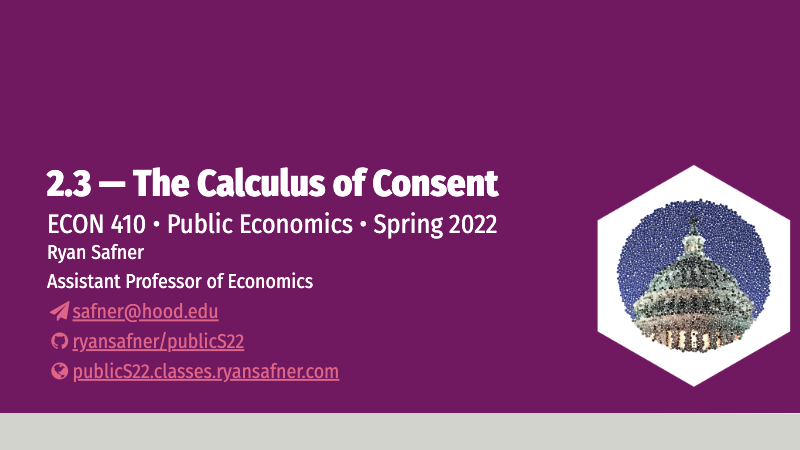Overview
After we’ve digested some political philosophy (with a dose of game theory), it’s time for a more “rigorous” model of choosing as a group. How should we decide how to decide?
We read the key chapters of Buchanan and Tullock’s classic 1962 Calculus of Consent, which (mostly) launched the field of public choice as the economic analysis of politics. Buchanan won the Nobel Prize in Economics in 1986 for his contributions to this field.
Readings
(No Required Questions or Discussion)
- Buchanan and Tullock (1962), The Calculus of Consent, Chs. 3,5,6
- Calculus of Consent Tool
Chapters 3 and 5 set up Buchanan and Tullock to talk about their subject — politics and constitutions — using economic analysis. It may seem a bit dry and excessive but remember, in 1962 almost nobody else thought politics could (or should) be analyzed with economic tools and assumptions like self-interested behavior! You can skim these chapters mostly, but focus on chapter 6 more closely, this is their actual model.
Questions to Guide Your Reading
“When will a society composed of free and rational utility-maximizing individuals choose to undertake action collectively rather than privately?”
How do we determine the rules that will determine the rules by which we choose as a group?
What is the moral significance, or special status, if any, of majority rule, i.e. \(\frac{n}{2}+1\) for deciding something?
When/why is unanimity important? When might it make rational sense to depart from unanimity as a decision rule?
What sorts of decisions should require more agreement, and what sorts of decisions should require less agreement?
How is the optimal decision rule deduced?
Should majorities decide everything? Why or why not?
Slides
Below, you can find the slides in two formats. Clicking the image will bring you to the html version of the slides in a new tab. Note while in going through the slides, you can type h to see a special list of viewing options, and type o for an outline view of all the slides.
The lower button will allow you to download a PDF version of the slides. I suggest printing the slides beforehand and using them to take additional notes in class (not everything is in the slides)!
